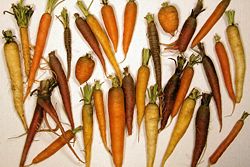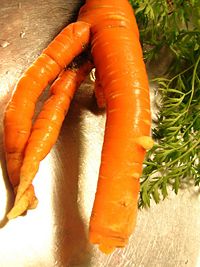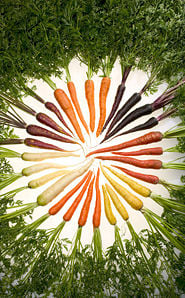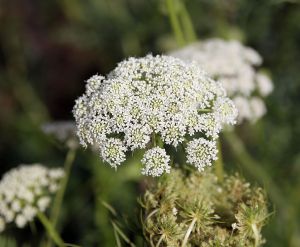Difference between revisions of "Carrot" - New World Encyclopedia
Katya Swarts (talk | contribs) |
Rosie Tanabe (talk | contribs) |
||
| (20 intermediate revisions by 5 users not shown) | |||
| Line 1: | Line 1: | ||
| − | {{ | + | {{Ebcompleted}}{{2Copyedited}}{{Approved}}{{Images OK}}{{Submitted}}{{Paid}}{{Copyedited}} |
{{Taxobox | {{Taxobox | ||
| Line 17: | Line 17: | ||
| binomial_authority = [[Carolus Linnaeus|L.]] | | binomial_authority = [[Carolus Linnaeus|L.]] | ||
}} | }} | ||
| − | |||
| − | + | '''Carrot''' is a herbaceous [[root vegetable]], ''Daucus carota'' subsp. ''sativus,'' in the parsley family (Apiaceae or Umbelliferae), which also includes the similar [[parsnip]]. The domesticated carrot is a cultivar of the wild carrot ''(Daucus carota),'' also known as "Queen Anne's lace," which is native to temperate parts of Europe and southwest Asia. The term carrot also applies to the long, edible, usually tapering taproot of the domesticated form. These taproots commonly are [[orange (color)|orange]] in color, but may be a variety of colors depending on the cultivar, including white, pink, yellow, or purple. They have a crisp texture when fresh. | |
| − | + | Carrots growing wild play a valuable role in the [[ecosystem]]: the [[leaf|leaves]] and [[root]]s are a source of food for animals, such as larvae of [[Lepidoptera]] species, and carrot [[flower]]s provide nectar for [[bee]]s, who in turn [[pollination|pollinate]] the plants. The domesticated carrot provides a [[nutrition|nutritious]] food for humans, and its distinctive flavor, texture, and color is a source of joy. Humans have learned how to cultivate this root vegetable, produce diverse cultivars of it, and prepare it in many ways, including eating it raw, cooking it in a soup or stew, making carrot cake, and so forth. | |
| − | == | + | ==Description== |
| − | + | ''Daucus carota'' is a member of the Apiaceae or Umbelliferae family (both names are allowed by the International Code of Botanical Nomenclature). This family comprises unusually aromatic plants with hollow stems, including the cumin, parsley, carrot, [[parsnip]], dill, caraway, fennel, and other relatives. The family also includes some highly toxic plants, such as [[hemlock]]. | |
| − | |||
| − | + | ''Apiaceae'' is a large family with about 300 genera and more than 3,000 species. The earlier name ''Umbelliferae'' derives from the [[inflorescence]] (arrangement of flowers on a stem) being in the form of a compound "[[umbel]]." Each umbel comprises many small radially symmetrical flowers with five small [[sepal]]s, five [[petal]]s, and five [[stamen]]s. | |
| − | The carrot | + | The wild carrot, ''Daucus carota,'' known also as ''bishop's lace'' or ''Queen Anne's lace,'' is a [[flowering plant]] in the family Apiaceae that is native to [[temperate]] regions of [[Europe]] and southwest [[Asia]]. ''Daucus carota'' subsp. ''sativus'' is the domesticated form of the [[wild carrot]] ''Daucus carota.'' It has been bred for its greatly enlarged and more palatable, less woody-textured edible taproot, but is still the same [[species]]. |
| − | + | Wild carrot is a variable [[biennial plant]], usually growing up to one meter (39 inches) tall and flowering from June to August. The [[umbel]]s are claret-colored or pale pink before they open, then bright white and rounded when their hundreds of tiny blossoms are in full [[flower]]. The umbels measure 3-7 centimeters (1.2 - 2.75 inches) wide with a whorl of narrow [[bracts]] beneath. Finally, as the flowers turn to [[seed]], the umbels contract and become concave like a bird's nest. This has given the plant its British common or vernacular name, ''bird's nest.'' Very similar in appearance to the deadly [[Conium|poison hemlock]], it is distinguished by a mix of bi-[[pinnate]] and tri-pinnate [[Leaf|leaves]], fine hairs on its stems and leaves, a root that smells like the cultivated carrots, and occasionally a single dark red flower in its center. | |
| − | [[ | + | Wild carrot was introduced and naturalized in [[North America]], where it is often known as "[[Anne of Denmark|Queen Anne]]'s lace." It is so called because the flower resembles lace; the red flower in the center represents a blood droplet where Queen Anne pricked herself with a needle when she was making the lace. The function of the tiny red flower, colored by [[anthocyanin]], is to attract insects. Because Queen Anne's lace was introduced into North America as a foreign species, the United States Department of Agriculture has listed it as a [[noxious weed]]. |
| − | + | The edible part of a domesticated carrot, ''Daucus carota'' subsp. ''sativus'' is a [[taproot]]. It grows a rosette of leaves in the spring and summer, while building up the stout taproot, which stores large amounts of [[sugar]]s for the [[plant]] to flower in the second year. The flowering stem grows to about one meter (39 inches) tall. | |
==History== | ==History== | ||
| − | The wild ancestors of the carrot are likely to have come from [[Afghanistan]], which remains the | + | The wild ancestors of the carrot are likely to have come from [[Afghanistan]], which remains the center of diversity of ''D. carota,'' the wild carrot. Selective breeding over the centuries of a naturally-occurring [[subspecies]] of the wild carrot, ''Daucus carota'' subsp. ''sativus'' has produced the familiar garden vegetable (Rose and O'Reilly 2006; Mabey 1997). |
| − | |||
| − | |||
| − | In | + | In early use, carrots were grown for their aromatic [[leaf|leaves]] and [[seed]]s, not their roots. Some relatives of the carrot are still grown for these, such as [[parsley]], [[fennel]], [[dill]], and [[cumin]]. The first mention of the root in classical sources is in the first century <small>C.E.</small> The modern carrot appears to have been introduced to Europe in the eighth to tenth centuries; [[Ibn al-Awam]], in [[Andalusia]], describes both red and yellow carrots. [[Simeon Seth]] also mentions both colors in the eleventh century. Orange-colored carrots appeared in the [[Netherlands]] in the seventeenth century (Dalby 1997). |
| − | + | In addition to wild carrot, these alternative (mostly historical) names are recorded for ''Daucus carota'': bee's-nest, bee's-nest plant, bird's-nest, bird's-nest plant, bird's-nest root, carota, carotte (French), carrot, common carrot, crow's-nest, daucon, dawke, devil's-plague, fiddle, gallicam, garden carrot, gelbe rübe (German), gingidium, hill-trot, laceflower, mirrot, möhre (German), parsnip (misapplied), Queen Anne's lace, rantipole, staphylinos, and zanahoria (Spanish) (Nowick 2007). | |
==Cultivars== | ==Cultivars== | ||
| − | [[Image:CarrotDiversityLg.jpg|thumb| | + | [[Image:CarrotDiversityLg.jpg|thumb|right|250px|Carrots come in a wide variety of shapes and sizes]] |
Carrot [[cultivar]]s can be grouped into two broad classes, '''eastern carrots''' and '''western carrots'''. More recently, a number of novelty cultivars have been bred for particular characteristics. | Carrot [[cultivar]]s can be grouped into two broad classes, '''eastern carrots''' and '''western carrots'''. More recently, a number of novelty cultivars have been bred for particular characteristics. | ||
===Eastern carrots=== | ===Eastern carrots=== | ||
| − | Eastern carrots were domesticated in Central Asia, probably in modern-day Afghanistan in the | + | Eastern carrots were domesticated in Central Asia, probably in modern-day [[Afghanistan]] in the tenth century, or possibly earlier. Specimens of the eastern carrot that survive to the present day are commonly purple or yellow, and often have branched roots. The purple color common in these carrots comes from [[anthocyanin]] pigments. |
===Western carrots=== | ===Western carrots=== | ||
| − | [[Image:ThreeRootCarrot.jpg|thumb| | + | [[Image:ThreeRootCarrot.jpg|thumb|left|200px|Carrots with multiple taproots (forks) are not specific cultivars, but are a byproduct of damage to earlier forks, often associated with rocky soil.]] |
| − | The western carrot emerged in the [[Netherlands]] in the | + | The western carrot emerged in the [[Netherlands]] in the fifteenth or sixteenth century, its orange color making it popular in those countries as an emblem of the [[House of Orange]] and the struggle for [[Dutch independence]]. The orange color results from abundant [[carotene]]s in these cultivars. While orange carrots are the norm in the West, other colors do exist, including white, yellow, red, and purple. These other colors of carrot are raised primarily as novelty crops. |
| − | The Vegetable Improvement Center at | + | The Vegetable Improvement Center at Texas A&M University has developed a purple-skinned, orange-fleshed carrot, the ''BetaSweet'' (also known as the maroon carrot), with substances to prevent [[cancer]], which has entered commercial distribution. |
Western carrot cultivars are commonly classified by their root shape: | Western carrot cultivars are commonly classified by their root shape: | ||
| − | * 'Chantenay' carrots are shorter than other cultivars, but have greater girth, sometimes growing up to | + | * ''Chantenay'' carrots are shorter than other cultivars, but have greater girth, sometimes growing up to eight centimeters (three inches) in diameter. They have broad shoulders and taper towards a blunt, rounded tip. They are most commonly diced for use in [[canning|canned]] or prepared foods. |
| − | * 'Danvers' carrots have a [[cone (geometry)|conical]] shape, having well-defined shoulders and tapering to a point at the tip. They are somewhat shorter than | + | * ''Imperator'' carrots are the carrots most commonly sold whole in U.S. supermarkets; their roots are longer than other cultivars of carrot, and taper to a point at the tip. |
| − | * ' | + | * ''Danvers'' carrots have a [[cone (geometry)|conical]] shape, having well-defined shoulders and tapering to a point at the tip. They are somewhat shorter than imperator cultivars, but more tolerant of heavy soil. Danvers cultivars are often [[puree]]d as [[baby food]]. |
| − | + | * ''Nantes'' carrots are nearly [[cylinder (geometry)|cylindrical]] in shape, and are blunt and rounded at both the top and tip. Nantes cultivars are often sweeter than other carrots. | |
| − | While any carrot can be harvested before reaching its full size as a more tender "baby" carrot, some fast-maturing cultivars have been bred to produce smaller roots. The most extreme examples produce round roots about 2.5 cm ( | + | [[Image:Carrots of many colors.jpg|thumb|right|185px|Carrots [[artificial selection|selectively bred]] to produce different colors]] |
| + | While any carrot can be harvested before reaching its full size as a more tender "baby" carrot, some fast-maturing cultivars have been bred to produce smaller roots. The most extreme examples produce round roots about 2.5 cm (one inch) in diameter. These small cultivars are also more tolerant of heavy or stony soil than long-rooted cultivars such as ''nantes'' or ''imperator.'' The "baby carrots" sold ready-to-eat in supermarkets are, however, often not from a smaller cultivar of carrot, but are simply full-sized carrots that have been sliced and peeled to make carrot sticks of a uniform shape and size. | ||
| − | Carrot flowers are pollinated primarily by [[bee]]s. Seed growers use [[honeybee]]s or [[mason bee]]s for their | + | Carrot flowers are [[pollination|pollinated]] primarily by [[bee]]s. Seed growers use [[honeybee]]s or [[mason bee]]s for their pollination needs. |
| − | Carrots are used as food plants by the [[larva]]e of some [[Lepidoptera]] species, including [[ | + | Carrots are used as food plants by the [[larva]]e of some [[Lepidoptera]] species, including [[common swift (moth)|common swift]], [[garden dart]], [[ghost moth]], and [[large yellow underwing]]. |
===Novelty carrots=== | ===Novelty carrots=== | ||
| − | |||
Food enthusiasts and researchers have developed other varieties of carrots through traditional breeding methods. | Food enthusiasts and researchers have developed other varieties of carrots through traditional breeding methods. | ||
| − | One particular variety lacks the usual orange pigment from carotenes, owing its white | + | One particular variety lacks the usual orange pigment from carotenes, owing its white color to a recessive gene for [[tocopherol]] (Vitamin E). Derived from ''Daucus carota'' L. and patented (US patent #6,437,222) at the University of Wisconsin-Madison, the variety is intended to supplement the dietary intake of Vitamin E. |
==Production trends== | ==Production trends== | ||
| − | [[Image:2005carrot_and_turnip.PNG|thumb|300px| | + | [[Image:2005carrot_and_turnip.PNG|thumb|300px|right|Carrot and [[Turnip]] output in 2005. Green: largest producer (China). Yellow: other major producers. Red: minor producers]] |
| − | In 2005, [[China]] was the largest producer of carrots and turnips, according to the | + | In 2005, [[China]] was the largest producer of carrots and turnips, according to the Food and Agricultural Organization, although figures from China sometimes are considered suspect. According to these figures, China accounted for at least one third of the global output, followed by [[Russia]] and the [[United States]]. |
| + | |||
| + | ==Uses== | ||
| + | [[Image:Carrot flowers.jpg|left|thumb|Carrot Flowers]] | ||
| + | Carrots can be eaten raw, whole, chopped, grated, or added to [[salad]]s for color or texture. They are also often chopped and boiled, fried or steamed, and cooked in [[soup]]s and [[stew]]s, as well as fine baby foods and select pet foods. A well known dish is ''carrots [[Julienning|julienne]].'' Grated carrots are used in [[carrot cake]]s, as well as [[carrot pudding]]s, an old English dish thought to have originated in the early 1800s. Together with [[onion]] and [[celery]], carrots are one of the primary vegetables used in a ''[[mirepoix (cuisine)|mirepoix]]'' to make various [[broth]]s. | ||
| + | |||
| + | The greens are edible as a [[leaf vegetable]], but are rarely eaten by humans. | ||
| + | |||
| + | Since the late 1980s, [[Baby Carrot|baby carrots]] or mini-carrots (carrots that have been peeled and cut into uniform cylinders) have been a popular ready-to-eat [[snack]] food available in many [[supermarket]]s. [[Carrot juice]] is also widely marketed. Baby carrots tend to be very tender, but not as flavorful as full grown carrots (Herbst 2001). | ||
| + | |||
| + | The carrot gets its characteristic orange color from [[Carotene|β-carotene]], which on consumption by humans is metabolized into [[vitamin A]]. Carrots are a rich source of vitamin A, with a 100 gram portion having about five to ten milligrams of carotene (Bender and Bender 2005). Massive overconsumption of [[carrots]] can cause [[hypercarotinemia]], a condition in which a person's skin appears orange (although this is superior to overdose effects of vitamin A, which can cause [[liver]] damage). | ||
| + | |||
| + | Carrots are also rich in [[dietary fiber]], [[antioxidant]]s, and [[dietary mineral|minerals]]. For best nutrition, the carrot greenery should be removed as soon as possible as it takes moisture and vitamins from the roots (Herbst 2001). | ||
| + | |||
| + | Lack of vitamin A can cause poor vision, and better vision can be restored by adding vitamin A back into the diet. A common [[urban legend]] in part based on this is that carrots aid a human being's [[night vision]]. It is believed that this myth partly stemmed from [[disinformation]] introduced in 1940 by the British Royal Air Force to cover up the discovery and use of [[radar]] technologies that was allowing pilots to be successful at night (Kruszelnicki 2005). It reinforced existing [[Germany|German]] [[folklore]] and helped to encourage children to eat the vegetable. | ||
| − | + | [[Ethnomedical]]ly, the roots are used to treat digestive problems, intestinal [[parasite]]s, and [[tonsilitis]]. | |
| − | |||
| − | |||
| − | |||
| − | |||
| − | |||
| − | |||
| − | |||
| − | |||
| − | + | [[Falcarinol]], a seventeen-carbon [[diyne]] [[fatty alcohol]] was isolated from carrot and [[red ginseng]] (Panax ginseng). It was shown to have potent anticancer properties on primary [[mammary]] [[epithelial]] cells ([[breast cancer]]) (CLC 2007). | |
| − | |||
| − | |||
| − | |||
| − | |||
| − | |||
| − | |||
| − | |||
| − | |||
| − | |||
| − | |||
| − | |||
==References== | ==References== | ||
| − | |||
| − | + | * Bender, D. A., and A. E. Bender. 2005. ''A Dictionary of Food and Nutrition.'' New York: Oxford University Press. ISBN 0198609612. | |
| − | + | ||
| − | * | + | * Cyberlipid Center (CLC). 2007. [http://www.cyberlipid.org/simple/simp0003.htm#10 Fatty alcohols]. ''Cyberlipid Center.'' Retrieved August 18, 2007. |
| − | + | ||
| − | + | * Dalby, A. 1997. ''Siren Feasts: A History of Food and Gastronomy in Greece.'' London: Routledge. ISBN 0415116201. | |
| − | + | ||
| − | + | * Dalby, A. 2003. ''Food in the Ancient World from A-Z.'' London: Routledge. ISBN 0415232597 | |
| − | * [http://www. | + | |
| − | * | + | * Herbst, S. T. 2001. ''The New Food Lover's Companion: Comprehensive Definitions of Nearly 6,000 Food, Drink, and Culinary Terms. Barron's Cooking Guide.'' Hauppauge, NY: Barron's Educational Series. ISBN 0764112589. |
| − | * | + | |
| − | + | * Kruszelnicki, K. S. 2005. [http://www.abc.net.au/science/k2/moments/s1392430.htm Great moments in science: Carrots & night vision]. ''Australian Broadcasting Corporation.'' Retrieved August 18, 2007. | |
| − | + | ||
| − | + | * Mabey, R. 1997. ''Flora Britannica.'' London: Chatto and Windus. ISBN 1856193772. | |
| − | + | ||
| − | * [http://www. | + | * Nowick, E. A. [http://www.unl.edu/agnicpls/gpcn/latind/Daucuscarota.html ''Daucus carota'']. ''University of Nebraska-Lincoln.'' Retrieved August 18, 2007. |
| − | + | ||
| − | * | + | * Rose, F., and C. O'Reilly. 2006. ''The Wild Flower Key.'' London: Frederick Warne. ISBN 0723251754 |
| − | * | + | |
| − | + | [[Category:Life sciences]] | |
| − | + | [[Category:Plants]] | |
| − | + | [[Category:Food]] | |
| − | |||
| − | * | ||
| − | |||
| − | |||
| − | |||
| − | |||
| − | + | {{credit|Carrot|150921227|Wild_carrot|147153292}} | |
Latest revision as of 20:21, 31 December 2019
| Carrot | ||||||||||||||
|---|---|---|---|---|---|---|---|---|---|---|---|---|---|---|
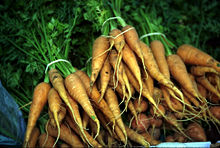 Harvested carrots
| ||||||||||||||
| Scientific classification | ||||||||||||||
| ||||||||||||||
| Daucus carota L. |
Carrot is a herbaceous root vegetable, Daucus carota subsp. sativus, in the parsley family (Apiaceae or Umbelliferae), which also includes the similar parsnip. The domesticated carrot is a cultivar of the wild carrot (Daucus carota), also known as "Queen Anne's lace," which is native to temperate parts of Europe and southwest Asia. The term carrot also applies to the long, edible, usually tapering taproot of the domesticated form. These taproots commonly are orange in color, but may be a variety of colors depending on the cultivar, including white, pink, yellow, or purple. They have a crisp texture when fresh.
Carrots growing wild play a valuable role in the ecosystem: the leaves and roots are a source of food for animals, such as larvae of Lepidoptera species, and carrot flowers provide nectar for bees, who in turn pollinate the plants. The domesticated carrot provides a nutritious food for humans, and its distinctive flavor, texture, and color is a source of joy. Humans have learned how to cultivate this root vegetable, produce diverse cultivars of it, and prepare it in many ways, including eating it raw, cooking it in a soup or stew, making carrot cake, and so forth.
Description
Daucus carota is a member of the Apiaceae or Umbelliferae family (both names are allowed by the International Code of Botanical Nomenclature). This family comprises unusually aromatic plants with hollow stems, including the cumin, parsley, carrot, parsnip, dill, caraway, fennel, and other relatives. The family also includes some highly toxic plants, such as hemlock.
Apiaceae is a large family with about 300 genera and more than 3,000 species. The earlier name Umbelliferae derives from the inflorescence (arrangement of flowers on a stem) being in the form of a compound "umbel." Each umbel comprises many small radially symmetrical flowers with five small sepals, five petals, and five stamens.
The wild carrot, Daucus carota, known also as bishop's lace or Queen Anne's lace, is a flowering plant in the family Apiaceae that is native to temperate regions of Europe and southwest Asia. Daucus carota subsp. sativus is the domesticated form of the wild carrot Daucus carota. It has been bred for its greatly enlarged and more palatable, less woody-textured edible taproot, but is still the same species.
Wild carrot is a variable biennial plant, usually growing up to one meter (39 inches) tall and flowering from June to August. The umbels are claret-colored or pale pink before they open, then bright white and rounded when their hundreds of tiny blossoms are in full flower. The umbels measure 3-7 centimeters (1.2 - 2.75 inches) wide with a whorl of narrow bracts beneath. Finally, as the flowers turn to seed, the umbels contract and become concave like a bird's nest. This has given the plant its British common or vernacular name, bird's nest. Very similar in appearance to the deadly poison hemlock, it is distinguished by a mix of bi-pinnate and tri-pinnate leaves, fine hairs on its stems and leaves, a root that smells like the cultivated carrots, and occasionally a single dark red flower in its center.
Wild carrot was introduced and naturalized in North America, where it is often known as "Queen Anne's lace." It is so called because the flower resembles lace; the red flower in the center represents a blood droplet where Queen Anne pricked herself with a needle when she was making the lace. The function of the tiny red flower, colored by anthocyanin, is to attract insects. Because Queen Anne's lace was introduced into North America as a foreign species, the United States Department of Agriculture has listed it as a noxious weed.
The edible part of a domesticated carrot, Daucus carota subsp. sativus is a taproot. It grows a rosette of leaves in the spring and summer, while building up the stout taproot, which stores large amounts of sugars for the plant to flower in the second year. The flowering stem grows to about one meter (39 inches) tall.
History
The wild ancestors of the carrot are likely to have come from Afghanistan, which remains the center of diversity of D. carota, the wild carrot. Selective breeding over the centuries of a naturally-occurring subspecies of the wild carrot, Daucus carota subsp. sativus has produced the familiar garden vegetable (Rose and O'Reilly 2006; Mabey 1997).
In early use, carrots were grown for their aromatic leaves and seeds, not their roots. Some relatives of the carrot are still grown for these, such as parsley, fennel, dill, and cumin. The first mention of the root in classical sources is in the first century C.E. The modern carrot appears to have been introduced to Europe in the eighth to tenth centuries; Ibn al-Awam, in Andalusia, describes both red and yellow carrots. Simeon Seth also mentions both colors in the eleventh century. Orange-colored carrots appeared in the Netherlands in the seventeenth century (Dalby 1997).
In addition to wild carrot, these alternative (mostly historical) names are recorded for Daucus carota: bee's-nest, bee's-nest plant, bird's-nest, bird's-nest plant, bird's-nest root, carota, carotte (French), carrot, common carrot, crow's-nest, daucon, dawke, devil's-plague, fiddle, gallicam, garden carrot, gelbe rübe (German), gingidium, hill-trot, laceflower, mirrot, möhre (German), parsnip (misapplied), Queen Anne's lace, rantipole, staphylinos, and zanahoria (Spanish) (Nowick 2007).
Cultivars
Carrot cultivars can be grouped into two broad classes, eastern carrots and western carrots. More recently, a number of novelty cultivars have been bred for particular characteristics.
Eastern carrots
Eastern carrots were domesticated in Central Asia, probably in modern-day Afghanistan in the tenth century, or possibly earlier. Specimens of the eastern carrot that survive to the present day are commonly purple or yellow, and often have branched roots. The purple color common in these carrots comes from anthocyanin pigments.
Western carrots
The western carrot emerged in the Netherlands in the fifteenth or sixteenth century, its orange color making it popular in those countries as an emblem of the House of Orange and the struggle for Dutch independence. The orange color results from abundant carotenes in these cultivars. While orange carrots are the norm in the West, other colors do exist, including white, yellow, red, and purple. These other colors of carrot are raised primarily as novelty crops.
The Vegetable Improvement Center at Texas A&M University has developed a purple-skinned, orange-fleshed carrot, the BetaSweet (also known as the maroon carrot), with substances to prevent cancer, which has entered commercial distribution.
Western carrot cultivars are commonly classified by their root shape:
- Chantenay carrots are shorter than other cultivars, but have greater girth, sometimes growing up to eight centimeters (three inches) in diameter. They have broad shoulders and taper towards a blunt, rounded tip. They are most commonly diced for use in canned or prepared foods.
- Imperator carrots are the carrots most commonly sold whole in U.S. supermarkets; their roots are longer than other cultivars of carrot, and taper to a point at the tip.
- Danvers carrots have a conical shape, having well-defined shoulders and tapering to a point at the tip. They are somewhat shorter than imperator cultivars, but more tolerant of heavy soil. Danvers cultivars are often pureed as baby food.
- Nantes carrots are nearly cylindrical in shape, and are blunt and rounded at both the top and tip. Nantes cultivars are often sweeter than other carrots.
While any carrot can be harvested before reaching its full size as a more tender "baby" carrot, some fast-maturing cultivars have been bred to produce smaller roots. The most extreme examples produce round roots about 2.5 cm (one inch) in diameter. These small cultivars are also more tolerant of heavy or stony soil than long-rooted cultivars such as nantes or imperator. The "baby carrots" sold ready-to-eat in supermarkets are, however, often not from a smaller cultivar of carrot, but are simply full-sized carrots that have been sliced and peeled to make carrot sticks of a uniform shape and size.
Carrot flowers are pollinated primarily by bees. Seed growers use honeybees or mason bees for their pollination needs.
Carrots are used as food plants by the larvae of some Lepidoptera species, including common swift, garden dart, ghost moth, and large yellow underwing.
Novelty carrots
Food enthusiasts and researchers have developed other varieties of carrots through traditional breeding methods.
One particular variety lacks the usual orange pigment from carotenes, owing its white color to a recessive gene for tocopherol (Vitamin E). Derived from Daucus carota L. and patented (US patent #6,437,222) at the University of Wisconsin-Madison, the variety is intended to supplement the dietary intake of Vitamin E.
Production trends
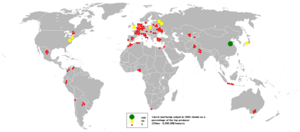
In 2005, China was the largest producer of carrots and turnips, according to the Food and Agricultural Organization, although figures from China sometimes are considered suspect. According to these figures, China accounted for at least one third of the global output, followed by Russia and the United States.
Uses
Carrots can be eaten raw, whole, chopped, grated, or added to salads for color or texture. They are also often chopped and boiled, fried or steamed, and cooked in soups and stews, as well as fine baby foods and select pet foods. A well known dish is carrots julienne. Grated carrots are used in carrot cakes, as well as carrot puddings, an old English dish thought to have originated in the early 1800s. Together with onion and celery, carrots are one of the primary vegetables used in a mirepoix to make various broths.
The greens are edible as a leaf vegetable, but are rarely eaten by humans.
Since the late 1980s, baby carrots or mini-carrots (carrots that have been peeled and cut into uniform cylinders) have been a popular ready-to-eat snack food available in many supermarkets. Carrot juice is also widely marketed. Baby carrots tend to be very tender, but not as flavorful as full grown carrots (Herbst 2001).
The carrot gets its characteristic orange color from β-carotene, which on consumption by humans is metabolized into vitamin A. Carrots are a rich source of vitamin A, with a 100 gram portion having about five to ten milligrams of carotene (Bender and Bender 2005). Massive overconsumption of carrots can cause hypercarotinemia, a condition in which a person's skin appears orange (although this is superior to overdose effects of vitamin A, which can cause liver damage).
Carrots are also rich in dietary fiber, antioxidants, and minerals. For best nutrition, the carrot greenery should be removed as soon as possible as it takes moisture and vitamins from the roots (Herbst 2001).
Lack of vitamin A can cause poor vision, and better vision can be restored by adding vitamin A back into the diet. A common urban legend in part based on this is that carrots aid a human being's night vision. It is believed that this myth partly stemmed from disinformation introduced in 1940 by the British Royal Air Force to cover up the discovery and use of radar technologies that was allowing pilots to be successful at night (Kruszelnicki 2005). It reinforced existing German folklore and helped to encourage children to eat the vegetable.
Ethnomedically, the roots are used to treat digestive problems, intestinal parasites, and tonsilitis.
Falcarinol, a seventeen-carbon diyne fatty alcohol was isolated from carrot and red ginseng (Panax ginseng). It was shown to have potent anticancer properties on primary mammary epithelial cells (breast cancer) (CLC 2007).
ReferencesISBN links support NWE through referral fees
- Bender, D. A., and A. E. Bender. 2005. A Dictionary of Food and Nutrition. New York: Oxford University Press. ISBN 0198609612.
- Cyberlipid Center (CLC). 2007. Fatty alcohols. Cyberlipid Center. Retrieved August 18, 2007.
- Dalby, A. 1997. Siren Feasts: A History of Food and Gastronomy in Greece. London: Routledge. ISBN 0415116201.
- Dalby, A. 2003. Food in the Ancient World from A-Z. London: Routledge. ISBN 0415232597
- Herbst, S. T. 2001. The New Food Lover's Companion: Comprehensive Definitions of Nearly 6,000 Food, Drink, and Culinary Terms. Barron's Cooking Guide. Hauppauge, NY: Barron's Educational Series. ISBN 0764112589.
- Kruszelnicki, K. S. 2005. Great moments in science: Carrots & night vision. Australian Broadcasting Corporation. Retrieved August 18, 2007.
- Mabey, R. 1997. Flora Britannica. London: Chatto and Windus. ISBN 1856193772.
- Nowick, E. A. Daucus carota. University of Nebraska-Lincoln. Retrieved August 18, 2007.
- Rose, F., and C. O'Reilly. 2006. The Wild Flower Key. London: Frederick Warne. ISBN 0723251754
Credits
New World Encyclopedia writers and editors rewrote and completed the Wikipedia article in accordance with New World Encyclopedia standards. This article abides by terms of the Creative Commons CC-by-sa 3.0 License (CC-by-sa), which may be used and disseminated with proper attribution. Credit is due under the terms of this license that can reference both the New World Encyclopedia contributors and the selfless volunteer contributors of the Wikimedia Foundation. To cite this article click here for a list of acceptable citing formats.The history of earlier contributions by wikipedians is accessible to researchers here:
The history of this article since it was imported to New World Encyclopedia:
Note: Some restrictions may apply to use of individual images which are separately licensed.
